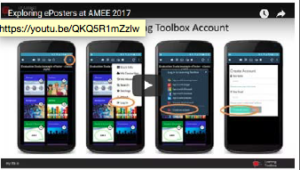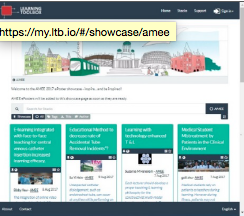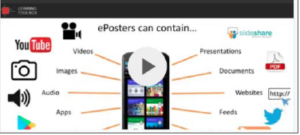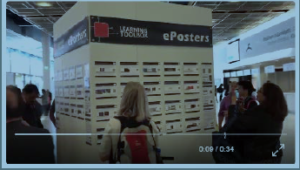Once again I am taking a look at some of the follow-up activities of our EU-funded Learning Layers (LL) project in the construction sector. As I have mentioned in my earlier blogs, my ITB-colleagues and the developers of the Learning Toolbox (LTB) have started cooperation with some German construction companies to launch company-specific pilot activities. In the first phase they agreed to start with feasibility studies. Last week the LTB developers were in Bremen and made some field visits to different sites of our partner organisations with ITB colleagues. At the end of the week we had a wrap-up meeting with one of the companies in ITB (and thus I could attend as an observer).
The approach
In the “Exploitation report” of the LL project we (in ITB) had already outlined our approach to such feasibility studies in the following way:
“Development of a framework for ‘Betriebsbezogene Analysetage’ for identifying company-specific points of intervention (for introducing tools and web resources), working interfaces (for identifying staff involved) and feedback processes (for specifying the benefits of tools etc.) to be supported with Learning Toolbox and affiliated tools and web resources.”
For me the point of interest was to learn, what kind of insights these field visits would bring into discussion regarding
- the use of digital media and web tools (in general) in the companies and in their trades, in particular
- as support for organisational and cross-organisational cooperation (specific to their trade) and
- as means to enhance process optimisation, learning and knowledge sharing across the organisation.
Getting an overview
Our counterpart in this discussion was the medium-sized company H. that is a major regional player in pipeline-building (Rohrleitungsbau) especially supply circuits (Versorgungsleitungen) and service pipes (Hausanschlüsse). It works together with the major electricity providers, water and gas suppliers and telephone and cable providers. Given the wide regional range of activities the company has in addition to its main office several branch offices and installation teams allocated to these offices. The company has framework contracts with its clients that include ordinary orders as well as procedures for emergency repairs. As a result, the company had adopted a ‘federative’ lean organisation that gives a lot of autonomy to the branch offices and to the teams that are working in the region. However, a major constrain for the organisation was to get the reporting of the work of the installation teams (and the clearance of ‘mission completed’) arranged in a smart way.
Given this complexity the LTB developers and my ITB colleagues carried out a series of interviews with the manager and the central IT specialist (in the central office) and with representatives of branch offices and skilled workers at different sites. With reference to the interview grid they then prepared a flow diagram that made transparent the work processes (including working interfaces), information flows (including interfaces with different forms for work orders and reporting) and points of intervention (where use of digital tools and web resources can contribute to process optimisation)
Insights and working issues
In the wrap-up meeting the representatives of the company H. discussed the preliminary findings with the LTB developers and my ITB-colleagues. Here I do not want to get into very specific details but highlight some of the main results:
a) Readiness to use digital media and web technologies: Firstly, already regarding the interaction with client organisations, there is a considerable variety between the ones that use up-to-date digital media (and web technologies) and others that rely on paper-based orders and printed reports. Inside the company the use of digital media and web technologies is generally accepted. Yet, in reporting from the field (with smartphones) there are still some teams that prefer using paper-based reporting.
b) Multiple dependencies and a variety of digital documents: In this trade (Rohrleitungsbau) it is typical that for one installation job the company has parallel orders from an energy provider, gas provider, water supplier etc. Typically these organisations use different software solutions, templates and forms. Also, the framework contracts include emergency repairs that need to be started without a separate order – but to be reported with yet another form. As a result the company H. has to deal with several types of digital and analogue documents that are not compatible with each other.
c) Engagement of different parts of the organisation in reporting: The installation works of the company are rather short-cycled ‘projects’ with one or two days’ duration. Yet, given the above mentioned diversity of software solutions and documents (and the varying readiness to use digital tools) there is a tendency towards duplication of reporting work at the construction site and in the office.
d) Autonomy of units/teams and knowledge sharing across the organisation: As has been mentioned, the organisational units at different branch offices – and the teams working in the field – have a great deal of autonomy. Also, their capability to find their own solutions is appreciated. The same is also the case with their way to handle the administrative reporting. However, the management is interested in encouraging knowledge sharing and exchange of experiences across the organisation. Yet, it appears that it is easier to arrange traditional training events (with frontal presentations by external experts) rather than events for shared learning within the organisation. The manager was looking for arrangements to support knowledge sharing among the skilled workers and with focus on improvements in work processes.
Working perspectives and lessons learned
The team of LTB-developers and ITB-colleagues will produce in a short while a brief report with further working perspectives and recommendations. However, already at this stage the flow diagram and the opportunity for joint reflections was appreciated – in the final meeting and during the field visits. Below I make some brief remarks, how (on the basis of the experience with the Learning Layers) the problems can be dealt with and how the organisation needs to engage itself in the next phase:
Concerning the multiple dependencies, different software solutions and document templates there is a possibility to introduce technical solutions – by introducing a company-specific database that communicates with the other kinds of documents (and manages the conversions). This requires some coordination in the central office, whilst the branches and the working teams should get their own documents, which they can at best handle. Furthermore, for the workers in the field it is possible to provide optional choices for reporting via typed documents or scanned documents (that can be converted in the central office). Such solutions would offload the administrative work from the teams and speed up the reporting for the clients. Here the manager emphasised the need to offload skilled workers from unnecessary administrative tasks. To him this would increase the attractiveness of craftsman careers.
Concerning the enhancement of learning and knowledge sharing across the organisation the experience of Learning Layers opens interesting prospects. Firstly, work process-oriented and technology-supported multimedia training can increase the readiness for knowledge sharing. Moreover, linking such training to shaping new stacks for Learning Toolbox can bring into picture practical solutions for such sharing. Here it is important to start from such tools and technologies that offload the participants from unnecessary burdens and make it possible to improve one’s contribution. Here the “Theme Room training” and the co-development of Learning Toolbox in the training centre Bau-ABC can serve as examples.
– – –
I think this is enough of our discussion in the wrap-up meeting. The LTB-developers and my ITB-colleagues will finalise their conclusions and recommendations in a short while. What strikes me in this discussion was the fact that we looked far deeper into learning in organisational contexts (and into process-optimisation in cross-organisational cooperation) than during the LL project. Moreover, it is difficult to find similar cases in the literature that we have been using. So, we have been dealing with an inspiring and challenging case. We hope that we can continue working together.
More blogs to come …





